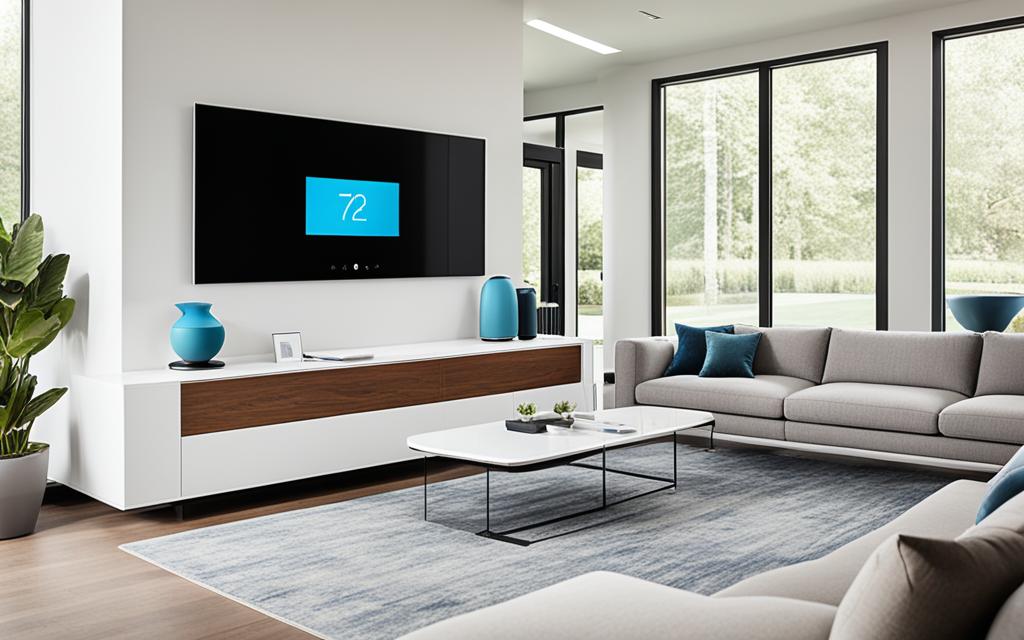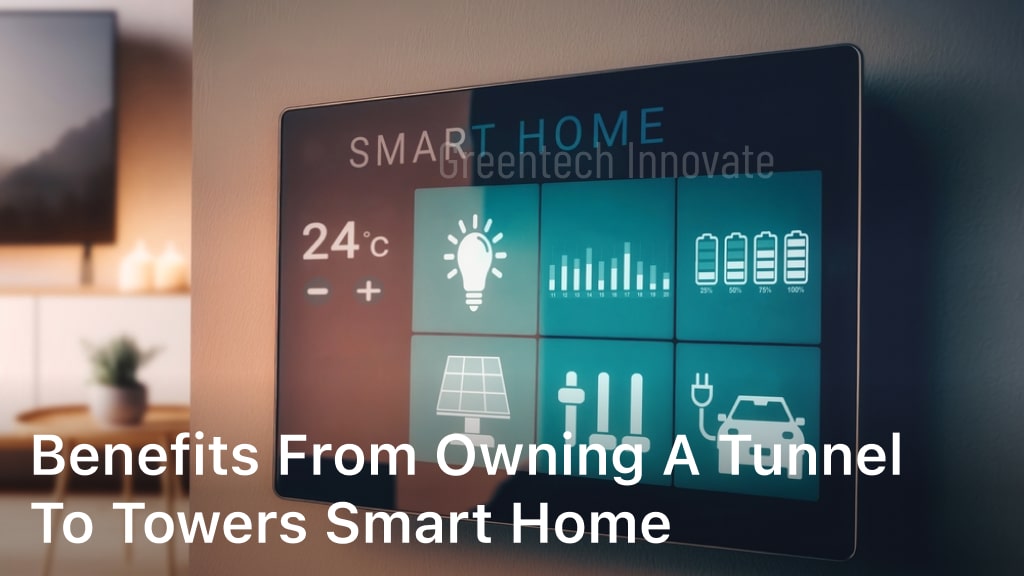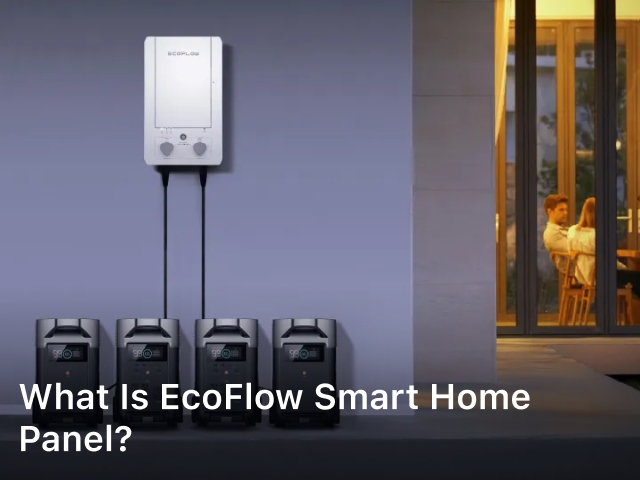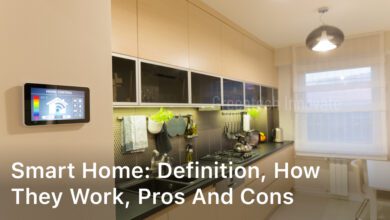
In today’s world, the idea of a “smart home” is making big waves. It changes how we live in our houses. Smart home technology uses devices connected to the internet to let us keep an eye on and control our homes from far away.
A smart home is filled with voice assistants, security systems, and energy-saving solutions. It also has smart appliances and entertainment. These things all work together. They give us more security, comfort, and save energy.
With apps on our phones or just our voices, we can control many home functions. We can change the temperature, adjust lights, and lock doors. This lets us run our homes exactly how we want, anytime.
Connected devices in a smart home talk to each other. They learn our habits and do things for us. This makes our homes smarter and more helpful. It’s like our homes really understand and respond to what we need.
Understanding Smart Home Technology
A smart home uses internet-connected devices for easy remote control of systems and devices. This technology, also called home automation or domotics, links devices to a central hub.
Definition of a Smart Home
In a smart home, internet-connected devices offer more safety, comfort, and energy efficiency. Examples include smart TVs, lights, thermostats, and more, which work together for an improved home experience.
How Smart Home Technology Works
A central hub acts as the system’s brain, letting homeowners manage their home via a smartphone or by voice. This setup allows for remote control and optimization of home features, like security and entertainment.
Benefits of Smart Home Technology
Smart homes boost security, comfort, and save energy. They can learn your habits and automate tasks, creating a personalized living space. With remote monitoring, you can always keep an eye on your home, no matter where you are.
Choosing Your Smart Home Ecosystem
When you start setting up a smart home, you need to pick a main system. You can choose from Google Home, Amazon Alexa, and Apple HomeKit.
Google Home
Google Home is powered by the Google Assistant. It’s great at understanding voice commands. It connects smoothly with Android gadgets. This makes controlling smart devices simple with just your voice.
Amazon Alexa
Amazon Alexa is known for its broad support, with over 100,000 skills. It works with a huge variety of smart products. To use it, you need the Alexa app. But, its wide ecosystem and continuous growth in supported devices attract many users.
Apple HomeKit
Apple HomeKit is secure and easy for those with iPhones or iPads. It controls your smart home through the Apple Home app. It focuses on keeping your data private and making your experience reliable and straightforward.
Other Ecosystems
Besides the top three, other ecosystems offer smart home options. Samsung SmartThings is one. It’s excellent for Samsung devices. Then, there are DIY systems like Home Assistant for those who want more freedom and creativity in managing their smart homes.
what is smart home technology
Smart home technology is about using devices connected to the internet for remote control and automation. It brings together various functions and appliances. These include lighting, temperature control, security, and entertainment, making them work as a team. This can all be controlled by apps on a smartphone, with voice commands, or by setting up schedules.
A smart home is a place where internet-connected devices allow you to keep an eye on and manage everything from a distance. It falls under the category of home automation. Its aim is to make life more secure, comfortable, convenient, and energy efficient for the homeowners. Doing this lets them control their smart devices with a smartphone app or voice.
The smart home setup has many devices like smart TVs, lights, thermostats, locks, and cameras. Even kitchen appliances can be a part of it. These devices are all connected and work together. They share information and follow your commands, making your home smarter and more integrated.
Essential Smart Home Devices
Creating a top-notch smart home needs some key devices. You should look into smart speakers, smart lighting, smart thermostats, and smart security. These gadgets will make your home more connected and easier to manage.
Smart Speakers and Smart Displays
Devices like the Amazon Echo and Google Nest Hub are game-changers. They let you use your voice to control various smart home features. From lights and music to checking who’s at the door, they work with you via voice commands and virtual assistants.
Smart Lighting Systems
Philips Hue and others offer smart lighting to brighten your home life. You can change colors, dim the lights, or set schedules from your phone. This is not just cool—it saves energy too. You can sync these lights with your voice assistant for the full effect.
Smart Thermostats
The Nest Learning Thermostat helps you save on energy without sacrificing comfort. It learns your routines to better manage your heating and cooling. You can tie it in with other smart devices for a fully optimized home experience.
Smart Security Systems
Security is key, and smart systems from companies like Ring and Frontpoint keep you safe. They offer video monitoring, smart locks, and more. Plus, you can control everything from your phone, boosting your home’s safety even when you’re not there.
Setting Up Your Smart Home
Starting a smart home isn’t as hard as it sounds. Begin by picking a reliable hub. This will control all your smart devices. Choose from Amazon Echo, Google Home, or Apple HomeKit. Each has special features to explore.
Choosing a Smart Home Hub
The hub you pick is crucial. It lays the groundwork for your smart home. Select one with many compatible devices and good voice control. It should also work smoothly with the smart home system you like. Make sure it’s easy to use and has a helpful app. Voice assistants such as Alexa, Google Assistant, or Siri can make your choice easier.
Ensuring Reliable Wi-Fi Connectivity
Good Wi-Fi is key for a smart home that works well. Check if your home’s Wi-Fi is strong everywhere. You might need a mesh system or Wi-Fi extenders. These can get rid of dead spots and keep your connection fast and steady.
Integrating Smart Home Devices
After securing your hub and Wi-Fi, add your smart devices. Make sure they work with your chosen hub. This could be Google Home, Amazon Alexa, or Apple HomeKit. Pick devices that use common communication types. This includes Bluetooth, Zigbee, Z-Wave, or the new Matter standard. It helps your devices work together smoothly.

Voice Control and Home Automation
Voice control and home automation are key parts of smart homes. Amazon Alexa, Google Assistant, and Apple Siri let you control your tech with your voice. You can use them with smart speakers and other devices to change lights, adjust the temperature, and more, just by talking.
Amazon Alexa
Amazon’s Alexa helps you run lots of smart home gadgets. If your products work with Alexa, you can turn lights on, change the room temperature, and handle your security system with voice commands.
Google Assistant
Google Assistant is Google’s voice-controlled helper for your smart house. It lets you do things like change the temperature or turn on the lights just by talking to it.
Apple Siri
Siri from Apple can also control smart home devices. If your gadgets support it, you can ask your iPhone, iPad, or Apple Watch to turn the lights on or do other tasks.
Home Automation Platforms
Big companies like Google, Amazon, and Apple offer platforms for automating your home. These platforms let you make schedules for different devices and make your home more convenient and energy efficient.
Ensuring Smart Home Security and Privacy
Smart home tech is advancing fast. It’s important to keep our networks safe and data private. We can do this by using the best security steps available.
Securing Your Smart Home Network
Your smart home network must be safe. There are a few key steps to achieve this. First, use strong passwords for your Wi-Fi. Second, separate your IoT devices to stop access to all if one is compromised. Third, always update your device and software to the latest versions. This means you have the newest security features.
Also, keep an eye on your network and add strong firewalls. These steps will make your smart home network even more secure.
Protecting Your Personal Data
Smart devices gather a lot of our personal data. They may collect our voice, location, and how we use things. It’s vital to protect this information. Start by reading the privacy policies of your devices. Then, adjust the settings to keep as much data private as possible.
It’s also good to check how companies use and store your data. Choose devices and services that are careful with your information. For added safety, use encryption and limit sharing your data. Know that you have rights as a consumer, too.
Troubleshooting and Maintenance
Maintaining a smart home is vital for it to work well. We face issues like lost connections, devices not working, and problems with mixing different brands. To fix these, we might reset devices, update their software, and make sure our Wi-Fi reaches everywhere in our home.
Common Smart Home Issues
Connectivity problems are often seen in smart homes. This means devices can’t connect to Wi-Fi, which stops us from using them from afar or fully using their features. Sometimes, devices like smart speakers won’t respond or smart locks won’t work right. Also, when mixing brands, devices might not talk to each other well due to different tech standards.
Updating Software and Firmware
It’s key to keep the software and firmware on our smart devices up to date. This keeps them safe, makes them work better, and helps them fit in with new tech. Companies update their products to fix bugs, add features, and meet the latest standards. Updating your devices means they work better and join the rest of your smart home smoothly.
| Troubleshooting Step | Description |
|---|---|
| Check Wi-Fi Connectivity | Make sure smart devices are on a strong network. Fixing Wi-Fi problems could mean resetting your router or locating interference. |
| Reset Devices | When devices act up, try resetting them. This can often fix issues and get them working properly again. |
| Update Software and Firmware | Always look for the newest updates for your smart devices. This stops security issues, fixes bugs, and maintains compatibility. |
| Verify Device Compatibility | Check that all your smart devices work together well within your chosen system. They should be able to easily communicate. |
Smart Home Standards and Protocols
A variety of wireless protocols and standards have emerged for smart homes. These allow devices to communicate smoothly. They make sure that all parts of a smart home work together correctly.
Wi-Fi
Wi-Fi is the top choice for connecting smart devices in homes. It lets you use the internet fast and easily control your devices from anywhere. Its broad reach and fast speeds are perfect for every smart home need.
Bluetooth
Bluetooth is great for devices that are close together. It might not go far, but it’s perfect for smart gadgets like speakers or lights. This means you can control them with ease, right from your phone or computer.
Zigbee
Zigbee is a special networking protocol for smart and IoT devices. It forms a network where devices can talk to each other to send information. This makes Zigbee great for homes full of smart tech.
Z-Wave
Another smart home protocol is Z-Wave, focused on being energy efficient. It works well with a wide range of devices, just like Zigbee. It’s a choice many make for their smart homes, thanks to its reliability and ability to grow.
Matter
Matter is the latest standard, aiming to make smart home devices work together easily. It’s supported by big names like Amazon and Apple. Matter promises to make setting up and adding devices a lot simpler, tackling the common issue of compatibility.
Future of Smart Home Technology
The world of smart home tech is changing fast. Soon, experts say our homes will be smarter thanks to AI and machine learning. This means our homes will know our needs better and work more automatically. New wireless tech, like the Matter standard, will make it all easier to use.
In the future, green energy and saving resources will be big in smart homes. People care more about our planet now. So, smart gadgets that save energy and use clean power will be everywhere.
Keeping our data safe will also be a top concern. As smart tech becomes common, protecting our info will be key. Companies will need to be clear about how they protect our privacy.
| Trend | Description |
|---|---|
| AI and Machine Learning | Improved automation and predictive capabilities through the integration of AI and machine learning algorithms in smart home devices. |
| Interoperability | Advancements in wireless protocols, such as Matter, to enhance seamless communication and integration between smart home devices from different manufacturers. |
| Energy Efficiency and Sustainability | Smart home devices that prioritize energy conservation and incorporate renewable energy sources to reduce environmental impact. |
| Privacy and Security | Increased focus on robust data protection measures and transparency from device manufacturers to ensure homeowner confidence in smart home technology. |
The future smart home will be better connected to what we need. It will understand us and keep up with our changing lifestyle. In time, it will make our lives more convenient, eco-friendly, and secure. Smart homes will blend into our daily life more than ever.
Conclusion
Smart home technology is changing how we live. It lets us connect many devices to the internet. This means we can make our homes safer, more efficient, and easier to control.
Now, smart speakers and lights can be voice-controlled. We also have security systems that work on their own. Climate settings can adjust automatically. These advancements make our lives better.
The future of smart homes looks bright. New developments in technology will make our homes even smarter. They will understand and meet our needs better than ever before.
As we head towards a future where homes are more connected, intelligent, and eco-friendly, life will get easier and better. Our homes will be tailor-made to fit our lives, offering an upgraded quality of living.




